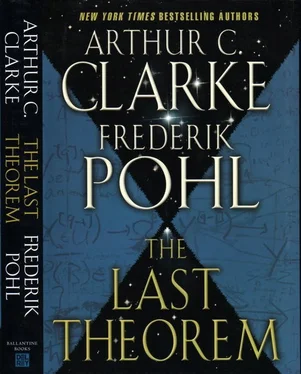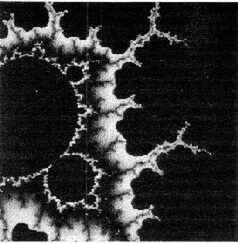The twenty-first century had not been good to either of the two countries. In Venezuela it was politics, in Colombia drugs; in both countries there had been violence and frequent governmental crises, capped by the decision of the former narcotics lords to take over some of their neighbor’s now far more profitable oil business.
“Pax per Fidem took on North Korea first because it didn’t have a real friend in the world,” Ranjit told his wife. “This time they took on two countries at once because they had different friends—the U.S. has been propping Colombia up since the nineties, and Venezuela was close to both Russia and China.”
“But there’s a lot less killing going on now,” Mevrouw said thoughtfully. “I can’t feel unhappy about that.”
Myra sighed. “But do you think we’ll be better off when the whole world is run by Oceania, Eurasia, and Eastasia?” she asked.
When the seminar was over, no student had managed to produce a rigorous proof of the infinitude of twin primes, but then Ranjit hadn’t expected one would. Neither had Dr. Davoodbhoy. At their postseminar conference, though, he was visibly happier than before. He flourished the student comment slips at Ranjit with a grin. “Listen to these. ‘I had the feeling I wasn’t just learning how to do mathematics; I was learning what doing mathematics was all about.’ ‘Good stuff. Dr. Subramanian doesn’t treat us like children, more like we were new members of his research team.’ ‘Can I take his next seminar, too?’ And what would you say to”—he glanced again at the slip—“this young lady, Ramya Salgado?”
Ranjit looked uncomfortable. “I know who she is; she was very active in the seminar. Maybe if we needed another warm body to fill the class out.”
“Oh,” said Dr. Davoodbhoy, “I don’t think you need to worry about that. You do want to do another, don’t you? Have you thought of a subject? Maybe something like the Riemann conjecture?”
“There are proofs of that,” Ranjit reminded him.
“Some people don’t think they’re satisfactory. Anyway, there was a proof of Fermat, too—Wiles’s—and that didn’t keep you from finding a better one.”
Ranjit considered, then shook his head. “I’m afraid Riemann is too complicated for anybody but a professional mathematician to care about. How are you going to get the average college student to care about what way the zeros in the Riemann zeta function are distributed? There are better ones around. Euler’s reworking of the Goldbach conjecture, for instance. That’s pure gold. ‘All positive even integers greater than four can be expressed as the sum of two primes.’ Six is three plus three, eight is five plus three, ten is five plus five—or seven plus three, if you like that better. Anybody can understand that! Only nobody has ever proved it—yet.”
Davoodbhoy considered for one of the smaller fractions of a second, then nodded. “Go for it, Ranjit. I might even like to audit one of those sessions myself.”
As the years flowed from that point in time onward, Ranjit began to realize that he truly loved teaching. Each semester brought a new flock of eager students, and of course he had his monthly reviews of the ladder to tend to, and Natasha was growing from a young, promising girl to a slightly older girl of significant promise. If anyone in the world shared Myra’s concerns about the three Pax per Fidem sponsors’ dividing the world among them, there was little sign of it. Silent Thunder was as gentle a conquistador in South America as it had been on the Korean peninsula. The casualty list was not much longer. The problems of feeding and caring for the suddenly technology-less populations were as quickly met. The outside world observed, and discussed, and seemed to think that Pax per Fidem had done a reasonably good thing.
Part of the reason why the affair had gone so well, Ranjit knew, was that the advance planning had been meticulous. Weeks before the attack the two surviving old American aircraft carriers had been loaded up with everything needed for the job, the goods supplied mostly by Russia and China. Fully prepared, they were deployed to the Gulf of Mexico—on “training missions,” the routine Department of Defense announcement said—and in fact ready to start supplying emergency help almost before the echoes of Silent Thunder’s nuclear blasts had died away. Even Myra had to admit that the effects had not been bad.
They were dawdling over a leisurely Sunday breakfast in the garden, just the three of them. Ranjit was checking some lecture possibilities on one screen, Myra idly following the news on another, while Natasha, who was nearing her twelfth birthday, practiced her backstroke in the pool. Then Myra looked up, sighing. “It looks like they’re coming to an agreement,” she told her husband. “Kenya and Egypt, and the other countries that depend on the Nile River water.”
He gave her a comfortable smile. “I thought they would,” he said. He had, in fact, all but guaranteed they would, at a time, no more than six months past, when the two principals had mobilized their not inconsiderable military might and sent the armies to glare at each other. But then the UN Security Council had favored them with one of its strongly worded warnings. “I guess they take the Security Council more seriously now, with Silent Thunder always looming,” Myra ruminated.
Ranjit demonstrated what an intelligent husband he was by omitting any “I told you so.” All he said was, “I’m glad they’re working it out. Listen. What would you think if I said my next seminar would be on the Collatz conjecture?”
Myra looked puzzled. “I don’t think I’ve ever heard of that one.”
“Probably not,” Ranjit agreed. “Most people haven’t. Old Lothar Collatz never got the publicity he was entitled to. Here, I’ll show you.” He turned his screen so that they could both see it. “Take any number—something under three digits; it works with really big ones just as well, but it takes too long. Got the number?”
Myra essayed, “Well, how about, say, eight?”
“Good one. Now divide it by two, and keep on dividing by two until you can’t get a whole-number answer anymore.”
Obediently Myra said, “Eight, four, two, one. Is that what you mean?”
“That is exactly what I mean. Wait a minute while I put it on the screen…. All right. That is what we will call rule number one for Collatz: When it’s an even number, divide it by two and keep on doing that until you don’t have an even number anymore. Now take an odd number.”
“Um…five?”
Ranjit sighed. “All right, we’ll just do the easy ones. So now we apply rule number two. If the number is odd, you multiply it by three and add one.”
“Fifteen…sixteen,” Myra supplied.
“Good. Now you’ve got an even number again, so you go back to rule one. Let me put that on the screen.”
As Ranjit quickly typed eight, four, two, one next to his other numbers, Myra raised her eyebrows. “Huh,” she said. “They look the same.”
Ranjit gave her a large smile. “That’s the point. You take any number, even the largest number you can think of, and work on it with just those two rules. Divide by two if it’s even, multiply by three and add one if it’s odd, and you’ll come down to one as a result every time. Even if the numbers you start with are pretty big—wait, I’ll show you.”
He typed some programming instructions onto the screen and gave it the number twenty-seven to start with. Alternating rules one and two as directed, the screen displayed “81… 82… 41… 123… 124… 62… 31… 93… 94… 47… 141… 142… 71… 213… 214… 107…” until Ranjit shut it off. “See how the number keeps bouncing up and down? It’s sort of pretty to watch, and sometimes the numbers get really large—there were some people at Carnegie Mellon who got it up to numbers with more than fifty thousand digits—but in the long run it always collapses to one.”
Читать дальше
Конец ознакомительного отрывка
Купить книгу










